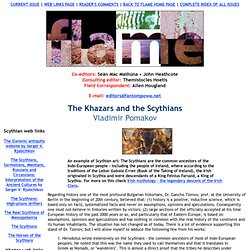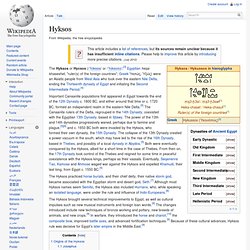

Small Mammals Have A 'Celtic Fringe' Too. Early Celtic 'Stonehenge' discovered in Germany's Black Forest. A huge early Celtic calendar construction has been discovered in the royal tomb of Magdalenenberg, nearby Villingen-Schwenningen in Germany's Black Forest.

This discovery was made by researchers at the Römisch-Germanisches Zentralmuseum at Mainz in Germany when they evaluated old excavation plans. Aboriginal Australians descended from early migration of modern humans out of Africa, study says. Genome sequencing study suggests that Aboriginal Australians are descended from early wave of modern humans who migrated out of Africa perhaps 62,000 - 75,000 years ago.

Little did he know that giving a team of scientists a lock of his hair would provide answers to some profound questions about the origins of humankind in his native Australia. But that is exactly what happened when scientists sequenced his genome and found that he was descended from a very ancient wave of modern humanity out of Africa and eventually into Australia some 62,000 - 75,000 years ago. He is an Aboriginal Australian. The results of the genetic tests showed that modern humans migrated into Eastern Asia in more than one wave and that he, along with all of his fellow Aboriginal Australians, could claim direct heritage with a very early wave, perhaps even the first wave. 3,000-year-old shipwreck shows European trade was thriving in Bronze Age. Tin ingots from this period have not been found in Britain before.

A bronze sword and three gold wrist bracelets, known as torcs, were also found at the spot, not far from the famous ''Salcombe Cannon'' wreck, which was discovered in the 1990s. The team have not found any of the new ship's actual body which is thought to have perished. However, it is likely to have been powered with paddles and had a crew of around 15. Modern Human Variation: Overview. New Hypothesis on the origins of the Khazars. Regarding history one of the most profound Bulgarian historians, Dr.

Gancho Tzenov, prof. at the University of Berlin in the beginning of 20th century, believed that: (1) history is a positive, inductive science, which is based only on facts, systematized facts and never on assumptions, opinions and speculations. Consequently one must not believe in histories written by victors; (2) large sections of the officially accepted at his time European history of the past 2000 years or so, and particularly that of Eastern Europe, is based on assumptions, opinions and speculations and has nothing in common with the real history of the continent and its human inhabitants. The situation has not changed as of today. New evidence links Early Bronze Age Ireland to the Southeastern United States - National Architecture & Design.
WALESKA, GA – May 24, 2011 (Examiner.com) For eleven years an enigmatic, 11 feet long boulder has been on display in the Hall of Ancients in the Funk Heritage Museum on the campus of Reinhardt University.

Thousands of people viewed the boulder. All thought it was something very “special.” Few visitors could make sense out of the concentric rings, circles with crosses, stars and something that looks like a dogwood flower or primitive rose. These carved symbols are known to archaeologists as petroglyphs. Did sex with Neanderthals and Denisovans shape our immune systems? The jury’s still out. Humans and Neanderthals had sex, but not very often. Tens of thousands of years ago, our ancestors spread across the world, having sex with Neanderthals, Denisovans and other groups of ancient humans as they went.

Today, our genes testify to these prehistoric liaisons. Last year, when the Neanderthal genome was finally sequenced, it emerged that everyone outside of African can trace 1 and 4 percent of their DNA from Neanderthals. The discovery was a vindication for some and a surprise to others. Climatic fluctuations drove key events in human evolution, researchers find. Research at the University of Liverpool has found that periods of rapid fluctuation in temperature coincided with the emergence of the first distant relatives of human beings and the appearance and spread of stone tools.

Dr Matt Grove from the School of Archaeology, Classics and Egyptology reconstructed likely responses of human ancestors to the climate of the past five million years using genetic modelling techniques. When results were mapped against the timeline of human evolution, Dr Grove found that key events coincided with periods of high variability in recorded temperatures. Dr Grove said: "The study confirmed that a major human adaptive radiation -- a pattern whereby the number of coexisting species increases rapidly before crashing again to near previous levels -- coincided with an extended period of climatic fluctuation. "By 1.5 million years ago we are left with a single human ancestor -- Homo erectus.
Aboriginal Australians: The first explorers. In an exciting development, an international team of researchers has, for the first time, pieced together the human genome from an Aboriginal Australian.

The results, published in the journal Science, re-interpret the prehistory of our species. By sequencing the genome, the researchers demonstrate that Aboriginal Australians descend directly from an early human expansion into Asia that took place some 70,000 years ago, at least 24,000 years before the population movements that gave rise to present-day Europeans and Asians. The results imply that modern day Aboriginal Australians are in fact the direct descendents of the first people who arrived in Australia as early as 50,000 years ago.
The study derived from a lock of hair donated to a British anthropologist by an Aboriginal man from the Goldfields region of Western Australia in the early 20th century. Separation New model for migration. Nevada's Mysterious Cave of The Red-Haired Giants. By Terrence Aym July 10, 2010 from IronLight Website.

Hyksos. The Hyksos or Hycsos (/ˈhɪksɒs/ or /ˈhɪksoʊz/;[3] Egyptian heqa khaseshet, "ruler(s) of the foreign countries"; Greek Ὑκσώς, Ὑξώς) were an Asiatic people from West Asia who took over the eastern Nile Delta, ending the Thirteenth dynasty of Egypt and initiating the Second Intermediate Period.[4] Important Canaanite populations first appeared in Egypt towards the end of the 12th Dynasty c. 1800 BC, and either around that time or c. 1720 BC, formed an independent realm in the eastern Nile Delta.[5] The Canaanite rulers of the Delta, regrouped in the 14th Dynasty, coexisted with the Egyptian 13th Dynasty, based in Itjtawy.

The power of the 13th and 14th dynasties progressively waned, perhaps due to famine and plague,[5][6] and c. 1650 BC both were invaded by the Hyksos, who formed their own dynasty, the 15th Dynasty. Origins of the Hyksos[edit] The history of the Sidhe. The History of the Sidhe The people known as "The Sidhe" or people of the mounds, or "The Lordly Ones" or "The Good People" were descended from the "Tuatha de Danann" who settled in Ireland millennia ago and in being defeated by the Milesians they retreated to a different dimension of space and time than our own, believed to be living under mounds and fairy raths and cairns, and also the land of "Tír na nÓg" a mythical island to the west of Ireland. Placenames in Ireland with the pre-nouns Lis, Rath, and Shee are associated with these people for example Lismore, Lisdoonvarna, Sheemore, Rathfarnham etc.
Llano Man Ancient American stone head sculpture. Over thirty thousand years ago, while Cro-Magnon man carved sculptures in Europe, Llano Man was shaping the stone heads of Malakov right here in Texas. The history of early man is often depicted with graphs, charts, reconstructed skulls, and artists renderings which imply two million years of gradual, progressive change—like a bridge across a River of Confusion.
In fact, what we have is a series of stepping stones with wide gaps between the various stages or types, and some stones branch off into the river and lead nowhere. Just as we are about to reach the opposite shore the last two stones are conveniently placed allowing us to stand on the solid ground of the present. Iran - 'the land of Aryans' Ginger. The naturally preserved body of an adult man was found in a cemetery at Gebelein, Egypt, and dated to the Late Predynastic period, around 3400 BC, or earlier. Ginger died more than five thousand years ago, yet his golden hair, which gave him his nick-name, and even his toe- and finger-nails were perfectly preserved.
Before mummification was developed to preserve human remains bodies were placed in shallow graves, in direct contact with the sand. Red hair. Red hair occurs naturally in 1–2% of the human population.[1] It occurs more frequently (2–6%) in people of northern or western European ancestry, and less frequently in other populations. Red hair appears in people with two copies of a recessive gene on chromosome 16 which causes a mutation in the MC1R protein.
[citation needed] Cultural reactions have varied from ridicule to admiration; many common stereotypes exist regarding redheads and they are often portrayed as fiery-tempered. Geographic distribution Historical Woman with red hair, Papua New Guinea. Several accounts by Greek writers mention redheaded people. Rus' people. The Rus' (Slavic: Русь; Greek: Ῥῶς) — ancient people who gave their name to the lands of Russia and Belarus. Their origin and identity are much in dispute. Russian scholars, along with some Westerners, consider the Rus to be a southeastern Slavic tribe that founded a tribal league - the Kievan state. Ibn Khordadbeh, a Persian geographer of the 9th century also believed the Rus people are Slavic. Traditional Western scholars believe them to be a group of Varangians — diverse groups of Norsemen.[1][2][3][4] According to the Primary Chronicle of Rus', compiled in about 1113 AD, the Rus' had relocated "from over sea", first to northeastern Europe, creating an early polity that finally came under the leadership of Rurik.
Etymology[edit] Varangians. The Physical Anthropology of Israelite Peoples. Homo sapiens - H. sapiens (Anatomically Modern Humans - AMH) are the species we belong to. Ancient DNA Reveals That Some Neanderthals Were Redheads. The Neanderthal theory of autism, Asperger and ADHD. Leif Ekblad, Independent Researcher Invented 2001-04-24 Last modified 2013-06-06 Modified reconstruction of Gibraltar Neanderthal child Credits Abstract Introduction Primate species Primate evolution Oreopithecus Ardipithecus Australopithecus Homo in Dmanisi Homo floresiensis Denisovans East Asian Homo Neanderthals Genetics Neanderthal nuclear-DNA Mitochondrial-DNA Y chromosome PDHA1 shows hybridization ADHD - DRD4 VNTR Skin color, hair color, freckles and eye color - MC1R Homo The cold adapted species The warm adapted species Homo Sapiens Could Neanderthals really be a true species?
Elizabeth Morgan Helped me with background material about various diseases like hemochromatosis, Factor V Leiden, cystic fibrosis, SLE, other autoimmune diseases, and found various links to supportative evidence Various autistic and ADHD individuals on discussion forums Helped me with ideas about behavior and provided comments about the theory. Operating system and the Neanderthal theory. NEandERthaL anatomy Human Evolution.